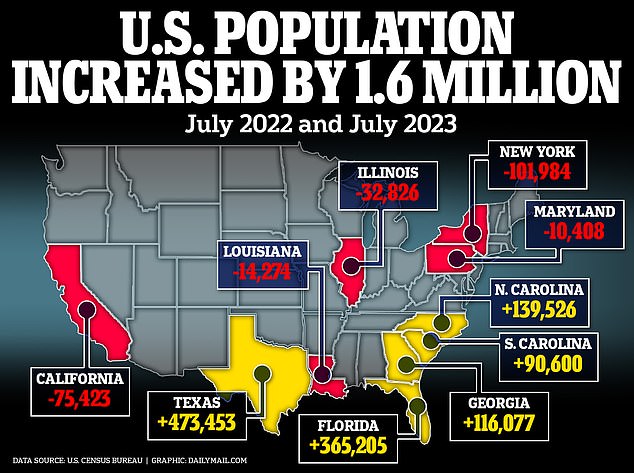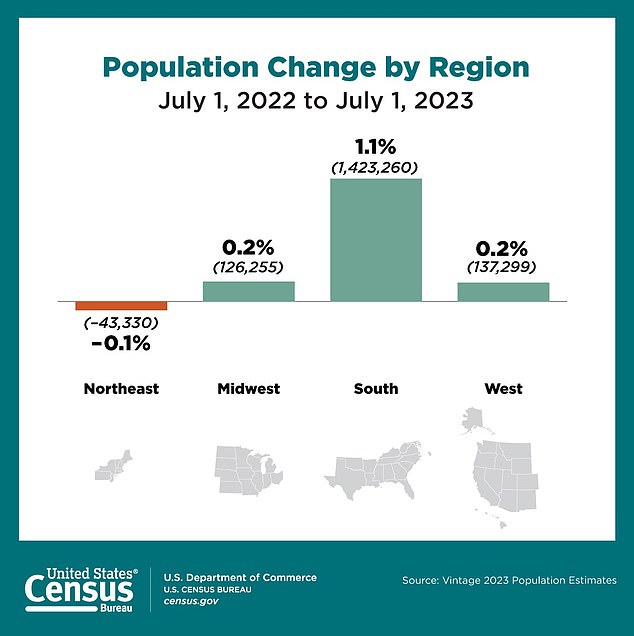Florida’s population surpassed the 23 million mark for the first time this year due to an influx of people moving from other states.
As of April 1 of this year, the Sunshine State had 23,002,597 residents, according to estimates released this month by the state’s Demographic Estimating Conference.
It is the third most populous state in the US, behind only California, with its 39.5 million inhabitants, and Texas, with its 30.5 million inhabitants.
Florida added nearly 359,000 people last year and has been adding between 350,000 and 375,000 people each year this decade, according to estimates.
Population growth is expected to peak this year and decline each subsequent year for the remainder of the 2020s as the final cohort of baby boomers entering retirement grows smaller, according to estimates.
Florida’s population surpassed the 23 million mark for the first time this year due to an influx of people moving from other states. (Pictured: Aerial view of Cape Coral in Florida)

Florida is the third most populous state in the United States, behind California, with 39.5 million residents, and Texas, with 30.5 million residents. (Pictured: A worker helps build a new home on September 22, 2023 in Miami, Florida)
By the early 2030s, Florida’s growth rate will be less than 1 percent, after reaching a projected 1.6 percent this year.
Since just before the onset of the COVID-19 pandemic in early 2020, all of Florida’s growth has come from people moving to the Sunshine State from other parts of the United States or from abroad.
Deaths have outpaced births in Florida since late 2019 and early 2020, and that trend is projected to continue well into the next decade.
Nearly 10 percent of Florida residents are 75 or older, second only to Puerto Rico among U.S. states and territories.
Other southern Republican states also saw significant population gains during 2023, while liberal northern states saw their losses offset by an influx of migrants.
The country’s population grew by 1.6 million over the past year, bringing the national total to 334.9 million.
Growth was driven primarily by Southern states, with 87 percent of the increase coming from Texas, Florida and South Carolina alone, according to the new data. Census Bureau numbers.

The country’s population grew by 1.6 million over the past year, bringing the national total to 334.9 million. The growth was driven primarily by southern states.

The nation’s population growth was driven primarily by Southern states, with 87 percent of the increases coming from Texas, Florida and South Carolina alone, according to new figures from the Census Bureau.
Amid the migration crisis at the border, Texas experienced the largest increase nationwide between July 2022 and July 2023, with nearly half a million new residents.
The Lone Star State was followed by Florida, Georgia, South Carolina and Tennessee, which also saw emigration from other states in the country.
“Growth in 2023 can largely be attributed to the region’s migration patterns, with 706,266 people added through net internal migration, while net international migration contributed nearly 500,000 to the total,” the report said.
Eight states, including New York, California and Illinois, saw their populations decline as many fled liberal cities due to high taxes and the cost of living.
In just one year, California lost 338,371 residents to other states, while New York State lost 216,778 and Illinois 83,839.
Those losses have been offset by tens of thousands more migrants moving north after crossing the U.S.-Mexico border into cities like Chicago and New York.
However, states still saw their overall populations decline due to the mass exodus of former residents to other states.
(tags to translate)dailymail

